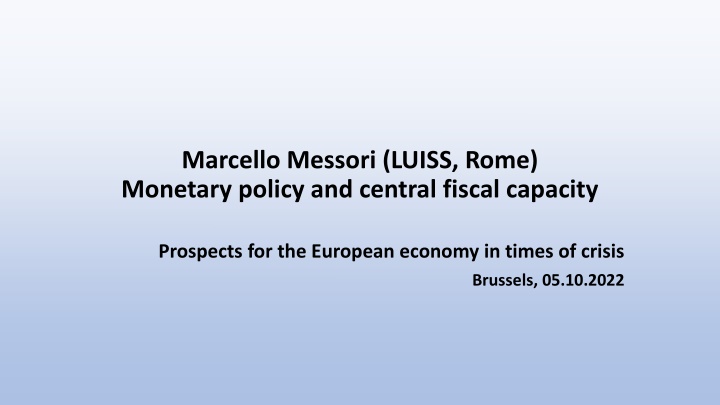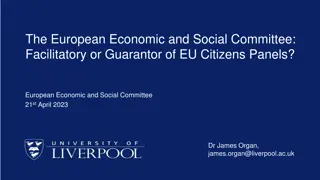
Managing European Economy: Monetary Policy & Fiscal Capacity
Discover insights on controlling inflation without risking stagflation in the Euro Area amidst supply-side challenges and geopolitical shocks like the invasion of Ukraine. Explore the need for a policy mix involving a Central Fiscal capacity to support the European economy and achieve a new equilibrium point.
Download Presentation

Please find below an Image/Link to download the presentation.
The content on the website is provided AS IS for your information and personal use only. It may not be sold, licensed, or shared on other websites without obtaining consent from the author. If you encounter any issues during the download, it is possible that the publisher has removed the file from their server.
You are allowed to download the files provided on this website for personal or commercial use, subject to the condition that they are used lawfully. All files are the property of their respective owners.
The content on the website is provided AS IS for your information and personal use only. It may not be sold, licensed, or shared on other websites without obtaining consent from the author.
E N D
Presentation Transcript
Marcello Messori (LUISS, Rome) Monetary policy and central fiscal capacity Prospects for the European economy in times of crisis Brussels, 05.10.2022
Aim of my intervention Given the questions addressed to the Panel, I would analyze points (3) and (2), that is: (i) how can the ECB put inflation under control without strengthening the risk of Euro Area s (EA s) stagflation; (ii) the definition of the related policy mix to limit the negative economic impact of the war in Ukraine. Focus on question (i); a few hints on question (ii).
EAs inflation under control without stagflation Main roots of EA s inflation: supply-side bottlenecks - unexpected persistence of the pandemic shocks - Russian invasion of Ukraine. Consequence: dramatic decrease in the aggregate supply. Current ECB s monetary policy (since March 2022) a downward adjustment in the aggregate demand. Best possible result: new equilibrium at an inflation rate close to 2% with a very severe recession ( negative output gap). Figure 1 = stylized representation of this sequence (see Buti Messori 2022a). New equilibrium monetary policy left alone = point C.
Alternative solution: policy mix Is it possible to reach an equilibrium different from C? It would be required an expansionary supply counter-shock. This counter-shock cannot be based on: - monetary policy left alone; - a combination of a moderate restrictive stance of ECB s policy and national fiscal policies (in the most fragile member states). Hence, a form of Central Fiscal capacity able to support the supply side of the European economy European Public Goods (to be combined with RRF) (Buti Messori 2022b). This policy mix should lead to the equilibrium point E.


